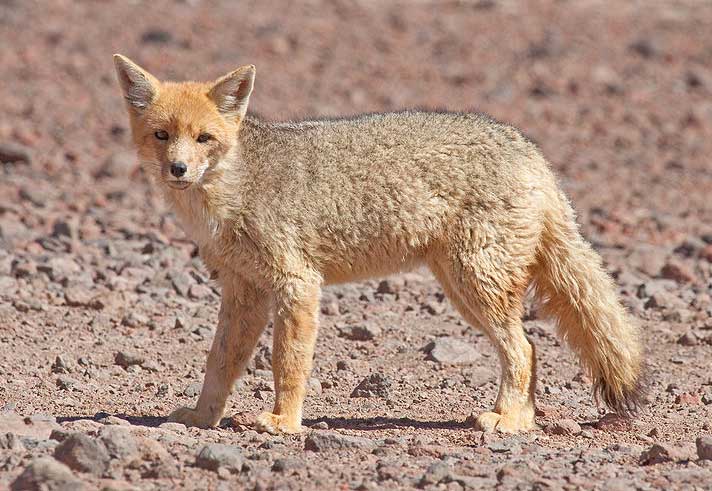Lycalopex culpaeus (*) Cladus: Eukaryota Name Lycalopex culpaeus (Molina, 1782) Type locality: "Chili" restricted by Cabrera (1931) to "the Santiago Province." References * Molina, G. I. 1782. Saggio sulla storia naturale del Chili. Stamperia di S. Tommaso d’Aquino, Bologna: 293.
The culpeo (Lycalopex culpaeus), sometimes known as the culpeo zorro or Andean fox (wolf), is a South American species of wild dog. It is the second largest native canid on the continent after the maned wolf. In its appearance it bears many similarities to the widely recognized red fox. It has grey and reddish fur, a white chin, reddish legs, and a stripe on its back that may be barely visible. The culpeo's diet consists largely of rodents, rabbits, birds and lizards, and to a lesser extent, plant material and carrion. The culpeo does attack sheep on occasion, and is therefore often hunted or poisoned.[2] In some regions it has become rare, but overall the species is not threatened with extinction.
This is a fairly large canid. The mean weight of the much larger male is 11.4 kg (25 lb), while females average 8.4 kg (19 lb). Total length can range from 82 to 152 cm (32 to 60 in), including a tail of 30 to 51 cm (12 to 20 in) in length. The pelage has a fairly attractive, grizzled appearance. The neck and shoulders are often tawny to rufous in color with the upper back is dark. The bushy tail has a black tip.[3] Range Its distribution extends from Ecuador and Peru to the southern regions of Patagonia and Tierra del Fuego. Some populations live in southern regions of Colombia. It is most common on the western slopes of the Andes, where it inhabits open country and deciduous forests. Populations of the culpeo are also found in some of the westernmost of the Falkland Islands, where they were introduced by humans. The extinct domestic perro Yaghan was probably a close relative. Diet The culpeo fox is an opportunistic predator that will take any variety of prey. This fox mainly feeds on rodents, lagomorphs (especially the introduced European rabbit and European hare) and occasionally feed on domestic livestock, and young guanacos.[4] They sometimes take young lambs a week old and younger. In limited studies, the larger culpeo appears to dominate potential competitors, including South American gray foxes, Geoffrey's cats, Pampas cats, grisons and various raptorial birds.[3] Habitat The culpeo lives in some areas in South America. They usually live in the areas where there are deserts, bushlands, upland mountains, and space plateaus, like Altiplano. Reproduction The typical mating period is between August and October. After a gestation period of 55-60 days, the female gives birth to cubs. The females usually give birth to 2-5 pups among the rocks. Subspecies Lycalopex culpaeus andinus (Thomas, 1914) References Source: Wikipedia, Wikispecies: All text is available under the terms of the GNU Free Documentation License |
|

